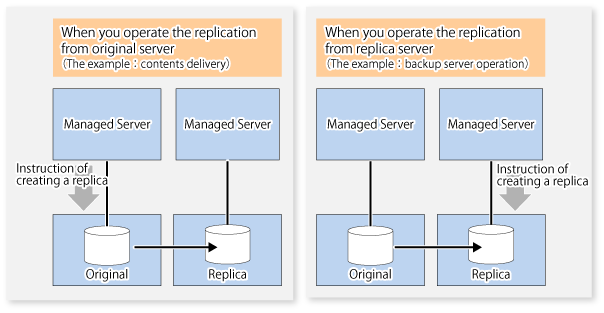Determine the source and replica volumes to be used in the replication.
Point
The source volume is the volume on which the data to be copied is stored.
The replica volume is the volume on which a copy of the data is stored.
Determine the following attributes to be assigned to source and replica volumes:
Copy direction
Determine the direction of copying. Specify one of the following directions:
Data can be copied in either direction between source volume and replica volume.
Data can only be copied from the source volume to the replica volume. During this operation, copying from the replica to the original volume is disabled.
Operational servers (used only for server-to-server replication)
In the case of replication between servers, you can specify whether to allow replication to be performed on either the source server or destination server, or on both servers.
Sets the Managed Server with the source volume that was connected as the operational server.
Sets the Managed Server with the replica volume that was connected as the operational server.
Sets both the source and destination servers as operational servers.
It is possible to create a group by arranging multiple source volumes and destination volumes.
In addition, the operation for multiple source volumes and destination volumes can be performed in a group. For details, refer to "6.4.7 Creating groups".
Figure 6.11 Servers used in performing replication

In this manual, a Managed Server used to perform replication is called the operational server. An original server or replica server is specified as the operational server.
An operational server can perform all of the replication functions. In contrast, any other type of server can use only the information display function and operational release function.
Note
In order to set up a volume as a source volume, there are some points which should be taken into consideration. For details, please refer to "9.1.1 General notes", for notes on determining a replication target.
Replication operations can copy data in Logical Units (disk units).
Logical Unit (disk) unit copying supports the following disk formats:
EFI labeled disks
VTOC labeled disks
To execute Logical Unit (disk unit) copy, refer to "9.1.1.11 Notes on executing Logical Unit (disk) unit copy".
Note
To copy a VTOC labeled disk, the second slice, indicating the entire disk, and the -Xvtoc option must be specified in setting of the original volume and replica volume.